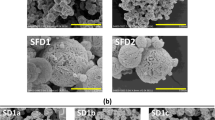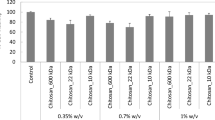Abstract
The purpose of this research was to prepare a dry powder vaccine formulation containing whole inactivated influenza virus (VIIV) and a mucoadhesive compound suitable for nasal delivery. Powders containing WIIV and either lactose or trehalose were produced by lyophilization. A micro-ball mill was used to reduce the lyophilized cake to sizes suitable for nasal delivery. Chitosan flakes were reduced in size using a cryo-milling technique. Milled powders were sieved between 45 and 125 μm aggregate sizes and characterized for particle size and distribution, morphology, and flow properties. Powders were blended in the micro-ball mill without the ball. Lyophilization followed by milling produced irregularly shaped, polydisperse particles with a median primary particle diameter of ≈21 μm and a yield of ≈37% of particles in the 45 to 125 μm particle size range. Flow properties of lactose and trehalose powders after lyophilization followed by milling and sieving were similar. Cryo-milling produced a small yield of particles in the desired size range (<10%). Lyophilization followed by milling and sieving produced particles suitable for nasal delivery with different physicochemical properties as a function of processing conditions and components of the formulation. Further optimization of particle size and morphology is required for these powders to be suitable for clinical evaluation.
Similar content being viewed by others
References
WHO. Influenza. WHO Fact Sheet, No 211. Geneva, Switzerland: World Health Organization; 2003.
Nichol KL, Mendelman PM, Mallon KP, et al. Effectiveness of live, attenuated intranasal influenza virus vaccine in healthy, working adults: a randomized controlled trial. JAMA. 1999; 282: 137–144.
Dyer O. Factory’s loss of licence halves supply of flu vaccine to US. BMJ. 2004; 329: 876.
Illum L. Nasal drug delivery: new developments and strategies. Drug Discov Today. 2002; 7: 1184–1189.
Groneberg DA, Witt C, Wagner U, Chung KF, Fischer A. Fundamentals of pulmonary drug delivery. Respir Med. 2003; 97: 382–387.
Roth Y, Chapnik JS, Cole P. Feasibility of aerosol vaccination in humans. Ann Otol Rhinol Laryngol. 2003; 112: 264–270.
Gonda I. The ascent of pulmonary drug delivery. J Pharm Sci. 2000; 89: 940–945.
Singh M, Briones M, O’Hagan DT. A novel bioadhesive intranasal delivery system for inactivated influenza vaccines. J Control Release. 2001; 70: 267–276.
Muszkat M, Friedman G, Schein MH, et al. Local SIgA response following administration of a novel intranasal inactivated influenza virus vaccine in community residing elderly. Vaccine. 2000; 18: 1696–1699.
Hirabayashi Y, Kurata H, Funato H, et al. Comparison of intranasal inoculation of influenza HA vaccine combined with cholera toxin B subunit with oral or parenteral vaccination. Vaccine. 1990; 8: 243–248.
Russell MW, Moldoveanu Z, White PL, Sibert GJ, Mestecky J, Michalek SM. Salivary, nasal, genital, and systemic antibody responses in monkeys immunized intranasally with a bacterial protein antigen and the Cholera toxin B subunit. Infect Immun. 1996; 64: 1272–1283.
Brgquist C, Johansson EL, Lagergard T, Holmgren J, Rudin A. Intranasal vaccination of humans with recombinant cholera toxin B subunit induces systemic and local antibody responses in the upper respiratory tract and the vagina. Infect Immun. 1997; 65: 2676–2684.
Smith DJ, Bot S, Dellamary L, Bot A. Evaluation of novel aerosol formulations designed for mucosal vaccination against influenza virus. Vaccine. 2003; 21: 2805–2812.
Anderson J, Fishbourne E, Corteyn A, Donaldson AI. Protection of cattle against rinderpest by intranasal immunisation with a dry powder tissue culture vaccine. Vaccine. 2000; 19: 840–843.
LiCalsi C, Christensen T, Bennett JV, Phillips E, Witham C. Dry powder inhalation as a potential delivery method for vaccines. Vaccine. 1999; 17: 1796–1803.
LiCalsi C, Maniaci MJ, Christensen T, Phillips E, Ward GH, Witham C. A powder formulation of measles vaccine for aerosol delivery. Vaccine. 2001; 19: 2629–2636.
Illum L, Jabbal-Gill I, Hinchcliffe M, Fisher AN, Davis SS. Chitosan as a novel nasal delivery system for vaccines. Adv Drug Deliv Rev. 2001; 51: 81–96.
Maa YF, Ameri M, Shu C, Payne LG, Chen D. Influenza vaccine powder formulation development: spray-freeze-drying and stability evaluation. J Pharm Sci. 2004; 93: 1912–1923.
Maa YF, Shu C, Ameri M, et al. Optimization of an alum-adsorbed vaccine powder formulation for epidermal powder immunization. Pharm Res. 2003; 20: 969–977.
Treanor JJ, Kotloff K, Betts RF, et al. Evaluation of trivalent, live, cold-adapted (CAIV-T) and inactivated (TIV) influenza vaccines in prevention of virus infection and illness following challenge of adults with wild-type influenza A (H1N1), A (H3N2), and B viruses. Vaccine. 1999; 18: 899–906.
Belshe RB, Mendelman PM, Treanor J, et al. The efficacy of live attenuated, cold-adapted, trivalent, intranasal influenzavirus vaccine in children. N Engl J Med. 1998; 338: 1405–1412.
FluMist [package insert]. Medlmmune Vaccines Inc., Gaithersburg, MD; 2003.
Soane RJ, Frier M, Perkins AC, Jones NS, Davis SS, Illum L. Evaluation of the clearance characteristics of bioadhesive systems in humans. Int J Pharm. 1999; 178: 55–65.
Huang J, Garmise RJ, Crowder TM, et al. A novel dry powder influenza vaccine and intranasal delivery technology: induction of systemic and mucosal immune responses in rats. Vaccine. 2004; 23: 794–801.
Martin AN, Bustamante P. Physical Pharmacy: Physical Chemical Principles in the Pharmaceutical Sciences. Philadelphia, PA: Lea & Febiger; 1993.
Carr RL Jr. Evaluating flow properties of solids. Chem Eng. 1965; 72: 163–168.
Carstensen JT. Pharmaceutical Principles of Solid Dosage Forms. Lancaster, PA: Technomic Pub; 1993.
Hickey AJ, Ganderton D. Pharmaceutical Process Engineering. New York, NY: Marcel Dekker; 2001.
Hinds WC. Aerosol Technology: Properties, Behavior, and Measurement of Airborne Particles. New York, NY: J Wiley; 1999.
Cleland JL, Langer RSAmerican Chemical Society. Division of Biochemical Technology. Formulation and Delivery of Proteins and Peptides. Washington, DC: American Chemical Society; 1994.
Hageman M. Water sorption and solid state stability of proteins. In: Ahern TJ, Manning MC, eds. Stability of Protein Pharmaceuticals. New York, NY: Plenum Press; 1992; 273–309.
Author information
Authors and Affiliations
Corresponding author
Additional information
Published: March 10, 2006
Rights and permissions
About this article
Cite this article
Garmise, R.J., Mar, K., Crowder, T.M. et al. Formulation of a dry powder influenza vaccine for nasal delivery. AAPS PharmSciTech 7, 19 (2006). https://doi.org/10.1208/pt070119
Received:
Accepted:
Published:
DOI: https://doi.org/10.1208/pt070119




